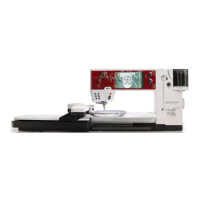96
Practical Applications
Blindstitch Wide no. 9
for medium weight to heavy fabric ►
Blindstitch Narrow no. 29
for fine fabrics (small stitches are visible on the right ►
side = decorative effect)
Preparation
finish the raw edges as desired ►
fold the hem and baste or pin in place ►
fold the garment back over the right side of the fabric to ►
expose the finished lower edge (see drawing)
place the work under the presser foot with the guide
►
positioned against the folded back fabric
Sewing
the needle should just pierce the edge of the fold ►
after sewing about 4” (10cm), check both sides of fabric ►
and adjust the stitch width if necessary
Blind
wide
narrow
Stretch Overlock no. 13
ideal for fluffy, thick materials such as terry cloth, felt ►
and leather
Sewing
fabric edges are overlapped and the stitch is placed on ►
the seam allowance which produces a very flat, durable
seam
sew stretch overlock along the fabric edge ►
the stitch should sew over the edge of the top layer of ►
fabric on the right swing of the needle
Flat Joining Seam
Backside of Fabric
Frontside
Blindstitch foot no. 5 ►
Reverse pattern foot no. 1C ►

